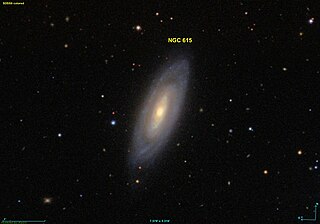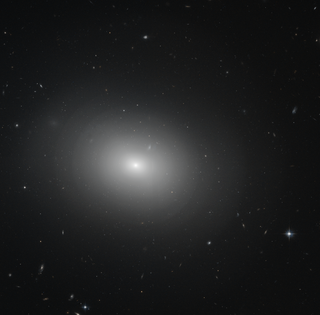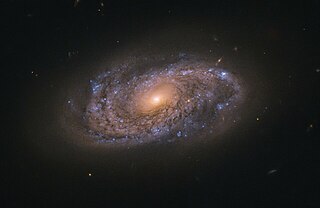
NGC 3642 is a spiral galaxy in the constellation Ursa Major. The galaxy has a low-ionization nuclear emission-line region. It is located at a distance of circa 30 million light years from Earth, which, given its apparent dimensions, means that NGC 3642 is about 50,000 light years across. The galaxy is characterised by an outer pseudoring, which was probably formed after the accretion of a gas rich dwarf galaxy.

NGC 4274 is a barred spiral galaxy located in the constellation Coma Berenices. It is located at a distance of circa 45 million light years from Earth, which, given its apparent dimensions, means that NGC 4274 is about 95,000 light years across. It was discovered by William Herschel in 1785.

NGC 4699 is an intermediate spiral galaxy located in the constellation Virgo. It is located at a distance of circa 65 million light years from Earth, which, given its apparent dimensions, means that NGC 4699 is about 85,000 light years across. It was discovered by William Herschel in 1786. It is a member of the NGC 4699 Group of galaxies, which is a member of the Virgo II Groups, a series of galaxies and galaxy clusters strung out from the southern edge of the Virgo Supercluster.

NGC 3726 is a spiral galaxy located in the constellation Ursa Major. It is located at a distance of circa 45 million light years from Earth, which, given its apparent dimensions, means that NGC 3726 is about 85,000 light years across. It was discovered by William Herschel on February 5, 1788.

NGC 5084 is a lenticular galaxy in the constellation of Virgo. It is located at a distance of about 80 million light years from Earth, which, given its apparent dimensions, means that NGC 5084 is at least 200,000 light years across. It is one of the largest and most massive galaxies in the Virgo Supercluster. William Herschel discovered it on March 10, 1785. It is a member of the NGC 5084 Group of galaxies, which is a member of the Virgo II Groups, a series of galaxies and galaxy clusters strung out from the southern edge of the Virgo Supercluster. The galaxy is seen nearly edge-on, with inclination 86°, and features a warped disk and large quantities of HI gas extending along the disk, probably accumulated after multiple accretions of smaller galaxies.

NGC 615 is an unbarred spiral galaxy seen edge-on located in the constellation Cetus. It is located at a distance of circa 70 million light years from Earth, which, given its apparent dimensions, means that NGC 615 is about 75,000 light years across. It was discovered by William Herschel on January 10, 1785. NGC 615 belongs to the NGC 584 galaxy group, which also includes the galaxies NGC 584, NGC 596, NGC 600, and NGC 636.

NGC 3893 is a spiral galaxy located in the constellation Ursa Major. It is located at a distance of circa 50 million light years from Earth, which, given its apparent dimensions, means that NGC 3893 is about 70,000 light years across. It was discovered by William Herschel on February 9, 1788. NGC 3893 interacts with its satellite, NGC 3896.

NGC 7606 is a spiral galaxy located in the constellation Aquarius. It is located at a distance of circa 100 million light years from Earth, which, given its apparent dimensions, means that NGC 7606 is about 165,000 light years across. It was discovered by William Herschel on September 28, 1785. The galaxy is included in the Herschel 400 Catalogue. It lies 45 arcminutes northeast from psi2 Aquarii. It can be seen with a 4 inch telescope but its visibility is greatly affected by light pollution.

NGC 7723 is a barred spiral galaxy located in the constellation Aquarius. It is located at a distance of circa 90 million light years from Earth, which, given its apparent dimensions, means that NGC 7723 is about 95,000 light years across. It was discovered by William Herschel on November 27, 1785. The galaxy is included in the Herschel 400 Catalogue. It lies 1.5 degrees north-northwest from Omega1 Aquarii. It can be seen with a 4-inch telescope under dark skies.

NGC 536 is a barred spiral galaxy located in the constellation Andromeda. It is located at a distance of circa 200 million light-years from Earth, which, given its apparent dimensions, means that NGC 536 is about 180,000 light years across. It was discovered by William Herschel on September 13, 1784. It is a member of Hickson Compact Group 10, which also includes the galaxies NGC 529, NGC 531, and NGC 542. It belongs to the Perseus–Pisces Supercluster.

NGC 4939 is a spiral galaxy located in the constellation Virgo. It is located at a distance of about 120 million light years from Earth, which, given its apparent dimensions, means that NGC 4939 is about 190,000 light years across. It was discovered by William Herschel on March 25, 1786.

NGC 5965 is a spiral galaxy located in the constellation Draco. It is located at a distance of circa 150 million light years from Earth, which, given its apparent dimensions, means that NGC 5965 is about 260,000 light years across. It was discovered by William Herschel on May 5, 1788.

NGC 5982 is an elliptical galaxy located in the constellation Draco. It is located at a distance of circa 130 million light years from Earth, which, given its apparent dimensions, means that NGC 5982 is about 100,000 light years across. It was discovered by William Herschel on May 25, 1788.

NGC 3585 is an elliptical or a lenticular galaxy located in the constellation Hydra. It is located at a distance of circa 60 million light-years from Earth, which, given its apparent dimensions, means that NGC 3585 is about 80,000 light years across. It was discovered by William Herschel on December 9, 1784.

NGC 1386 is a spiral galaxy located in the constellation Eridanus. It is located at a distance of circa 53 million light years from Earth, which, given its apparent dimensions, means that NGC 1386 is about 50,000 light years across. It is a Seyfert galaxy, the only one in Fornax Cluster.

NGC 5363 is a lenticular galaxy located in the constellation Virgo. It is located at a distance of circa 65 million light years from Earth, which, given its apparent dimensions, means that NGC 5363 is about 100,000 light years across. It was discovered by William Herschel on January 19, 1784. It is a member of the NGC 5364 Group of galaxies, itself one of the Virgo III Groups strung out to the east of the Virgo Supercluster of galaxies.

NGC 3729 is a barred spiral galaxy located in the constellation Ursa Major. It is located at a distance of circa 65 million light years from Earth, which, given its apparent dimensions, means that NGC 3729 is about 60,000 light years across. It was discovered by William Herschel on April 12, 1789.

NGC 2906 is a spiral galaxy located in the constellation Leo. It is located at a distance of circa 120 million light years from Earth, which, given its apparent dimensions, means that NGC 2906 is about 75,000 light years across. It was discovered by William Herschel on December 28, 1785.

NGC 4589 is an elliptical galaxy located in the Draco constellation. It is at a distance of about 108 million light-years away from the Earth. It is known by its designations PGC 42139 or UGC 7797.

NGC 7513 is a barred spiral galaxy located in the constellation Sculptor. It is located at a distance of circa 62.5 million light years from Earth, which, given its apparent dimensions, means that NGC 7513 is about 75,000 light years across. It was discovered by Albert Marth on September 24, 1864.




















